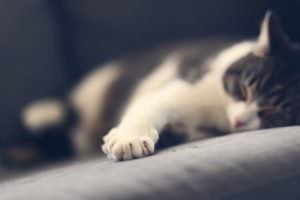While banned in many European countries, declawing cats is common in the United States. People see it as a solution to stop their feline friends from scratching their couches and door frames and digging their claws into expensive clothes and carpets. The surgery removes a cat’s front claws to keep furniture safe, but recent research shows it also has long-term consequences.
The Journal of Feline Medicine and Surgery published a study in which a total of 274 cats were monitored. Half of the felines already had their claws removed. The researchers observed the cats in their everyday lives and provided each with thorough health exams. Their results showed the cats who had undergone the declawing surgery were more prone to behaviors including aggression and over-grooming. They bit humans more often and refused to use the litter box.
Researchers concluded these behaviors to be three to seven times more common in declawed cats. As for the health of the cats, those without claws were three times more likely to experience chronic back pain than their clawed feline friends.
The reasons behind their findings have to do with the details of the declawing surgery, also called onychectomy. Many people think it’s simply an extreme version of nail trimming, but declawing is much more than that.
In order to completely remove the claw, part of the bone is also taken. The toe is amputated at the first knuckle, and bone, tendons, and claw are removed all at once. This is done ten times on each of a cat’s front paws. In the countries where it’s illegal, including the UK, Germany, Switzerland, and Sweden, declawing cats is considered to be a form of mutilation.
Declawing is extremely painful, and cats express their pain in ways that some humans may not understand. They’re grumpy because they’re hurting, and they’re aggressive because they have no other way to tell humans something is wrong. Their chronic back pain is most likely a result of the cat being forced to change its gait due to its shortened limbs.
In the study, 63 of the declawed cats experienced pain at the surgery site long after the procedure. Others showed signs of lameness and an unwillingness to move or bear weight on the affected paws.
None of the declawed cats will ever destroy another sofa, but at what cost? When it comes to declawing cats, pet owners need to decide what matters most. Do they want to protect their furniture from a cat following its natural instincts to scratch, or do they want their pet to live a happy, pain-free life?



